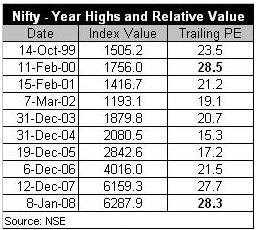I am no analyst when it comes to an area like this, but my portfolio has consistently out-performed those of experts and for that reason, I feel obliged to share my wisdom and relieve the common folk of their miseries. Most message boards/ Q&A sessions that I participate, have very simple questions for which the analysts and experts give complex undecipherable answers with a lot ofjargon's that leave the questioner even more confused. The problem as I see with many investors, is that they are not sure why they went in for a particular investment be it stocks or Mutual Funds (MF) or other types.If you are blindly following a recommendation of your friend or a broker, then that could be your problem. If you need a washing machine that can wash and rinse on one touch, then would you buy a semi automatic one just because the sales man recommended that to be the best deal.
In many cases, If you have done your research, it wouldn't matter what kind of investment you make and what the cost price of your investment is. I am going to list a few cliches below that would stand in good stead for equity investors in the long run. Some of these can be generically applied to other kinds of investment.
- Patience is a virtue - Companies take time to grow and they evolve as they grow there by increasing value to share holders. At difficult times, they test your patience and question your judgement. At these times, review your decision and see if somethingfundamental has changed. Base your decisions on your review.
- Identify your investment style - Are you a aggressive investor looking for 50 % returns in a year or are you a passive investor looking for a moderate 15% return and so on. Place your bets based on what you are expectations are. Small companies may grow fasteras compared to the bigger ones and may suit an aggressive investor Traditionally Large caps give you a moderate return as compared to small and mid ones. The risks are always in directproportion to your returns, so choose wisely.
- Have a plan in place - When you invest in an asset, decide how long you may want to hold it, and review periodically. If you have decided to hold a stock for 5 years, then identify your return goals and review the same periodically. If you purchased a stock 'x' for 100 in 2005 and expect it to grow to 1000 by 2010, then do not look at it's share price everyday, but review it periodically to ensure that it will become 1000 by 2010. Reinvest if required and do not get stuck with the stock, for the sake of it. A wrong judgement when corrected early can prevent bigger losses.
- Invest systematically - Very self explanatory, make sure you set aside some part of your money every month for investments,Do not delay investments for the sake of expenses. Discipline with investment is what will create wealth.
- Start early - The power of compounding is something that will astonish you. Invest regularly, and over time your investments will grow in multiples. A one year delay on your start could push you behind the race for wealth.In fact have a retirement plan in place so you know when you need to start investing and how much you need to invest every month.
- Suresh
The author works for a Global IT consulting organisation as a IT consultant. He is currently based out of London. The views expressed in this article are his own. All copyrights and Trade Marks are duly acknowledged. He can be reached via the link on the right tab on this page.
